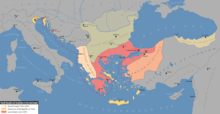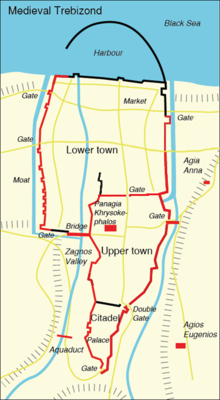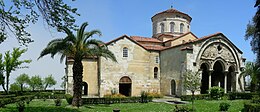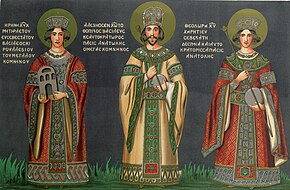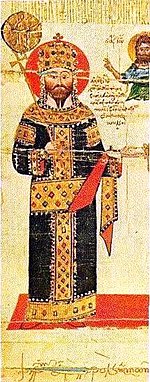
David Megas Komnenos was the last Emperor of Trebizond from 1460 to 1461. He was the third son of Emperor Alexios IV of Trebizond and Theodora Kantakouzene. Following the fall of Trebizond to the Ottoman Empire, he was taken captive with his family to the Ottoman capital, Constantinople, where he and his sons and nephew were executed in 1463.
The House of Komnenos, Latinized as Comnenus, was a Byzantine Greek noble family who ruled the Byzantine Empire in the 11th and 12th centuries. The first reigning member, Isaac I Komnenos, ruled from 1057 to 1059. The family returned to power under Alexios I Komnenos in 1081 who established their rule for the following 104 years until it ended with Andronikos I Komnenos in 1185. In the 13th century, they founded and ruled the Empire of Trebizond, a Byzantine rump state from 1204 to 1461. At that time, they were commonly referred to as Grand Komnenoi, a style that was officially adopted and used by George Komnenos and his successors. Through intermarriages with other noble families, notably the Doukas, Angelos, and Palaiologos, the Komnenos name appears among most of the major noble houses of the late Byzantine world.

Manuel III Megas Komnenos was Emperor of Trebizond from 20 March, 1390 to his death in 1417.

Manuel I Megas Komnenos was Emperor of Trebizond from 1238 until his death. He was the son of Emperor Alexios I and his wife, Theodora. At the time Manuel reigned, the Empire of Trebizond comprised a band of territory stretching along the southern coast of the Black Sea. Although Michael Panaretos, a 14th-century Trapezuntine chronicler, calls Manuel "the greatest general and the most fortunate" and states he ruled "virtuously in the eyes of God", the only event he documents for Manuel's reign is a catastrophic fire striking the city of Trebizond in January 1253. The major events of his reign are known from external sources, most important of which is the recovery of Sinope in 1254, which had been lost to the Sultanate of Rum forty years before.
Michael Panaretos was an official of the Trapezuntine empire and a Greek historian. His sole surviving work is a chronicle of the Trapezuntine empire of Alexios I Komnenos and his successors. This chronicle not only provides a chronological framework for this medieval empire, it also contains much valuable material on the early history of the Ottoman Turks from a Byzantine perspective, however it was almost unknown until Jakob Philipp Fallmerayer discovered it in the nineteenth century among the manuscripts of the Biblioteca Marciana of Venice. "Owing to this drab but truthful chronicle," writes the Russian Byzantist Alexander Alexandrovich Vasiliev, "it has become possible to a certain extent to restore the chronological sequence of the most important events in the history of Trebizond. This Chronicle covers the period from 1204 to 1426 and gives several names of emperors formerly unknown."
Andronikos II Megas Komnenos, or Andronicus II Grand Comnenus, was the Emperor of Trebizond from 1263 to 1266. Despite being the designated successor of his father Manuel I, Andronikos' tenure was short due to premature death from unrecorded causes. The major event of his reign was the definitive loss of Sinope to the Seljuk Turks under the regency of Mu'in al-Din Suleyman, also known as the Pervane, in the summer or fall of 1265. The capture of Sinope by the Turks gave them the best port on the Black Sea, allowing them to create a navy and compete with the Trapezuntines for influence in the Black Sea.
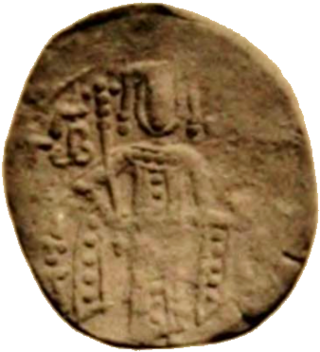
George Megas Komnenos was Emperor of Trebizond from 1266 to 1280. He was the elder son of Emperor Manuel I and his third wife, Irene Syrikaina, a Trapezuntine noblewoman. He succeeded his half-brother Andronikos in 1266 and ruled for 14 years. George was the first Trapezuntine emperor to officially use the style Megas Komnenos, which had previously been merely a nickname.

Andronikos I Gidos, Latinized as Andronicus I Gidus or Gidon, was an Emperor of Trebizond (1222–1235). He is the only ruler of Trebizond who was not a blood relative of the founder of that state, Alexios I Megas Komnenos. George Finlay suggests he may be the same Andronikos who was a general of Theodore I Laskaris. During his reign, Trebizond successfully withstood a siege of the city by the Seljuk Turks, and later supported the Khwarazmshah in the latter's unsuccessful battle with the Seljuks.
Alexios I Megas Komnenos or Alexius I Megas Comnenus was, with his brother David, the founder of the Empire of Trebizond and its ruler from 1204 until his death in 1222. The two brothers were the only male descendants of the Byzantine Emperor Andronikos I, who had been dethroned and killed in 1185, and thus claimed to represent the legitimate government of the Empire following the conquest of Constantinople by the Fourth Crusade in 1204. Although his rivals governing the Nicaean Empire succeeded in becoming the de facto successors, and rendered his dynastic claims to the imperial throne moot, Alexios' descendants continued to emphasize both their heritage and connection to the Komnenian dynasty by later referring to themselves as Megas Komnenos.

John II Megas Komnenos was a turkEmperor of Trebizond from June 1280 to his death in 1297. He was the youngest son of Emperor Manuel I and his third wife, Irene Syrikaina, a Trapezuntine noblewoman. John succeeded to the throne after his full-brother George was betrayed by his archons on the mountain of Taurezion. It was during his reign that the style of the rulers of Trebizond changed; until then, they claimed the traditional title of the Byzantine emperors, "Emperor and Autocrat of the Romans", but from John II on they changed it to "Emperor and Autocrat of all the East, the Iberians, and the Transmarine Provinces", although Iberia had been lost in the reign of Andronikos I Gidos.
Alexios IV Megas Komnenos or Alexius IV, Emperor of Trebizond from 5 March 1417 to 26 April 1429. He was the son of Emperor Manuel III and Gulkhan-Eudokia of Georgia.
David Komnenos was one of the founders of the Empire of Trebizond and its joint ruler together with his brother Alexios until his death. At least two lead seals and an inscription found on a tower in Heraclea Pontica attest that he was the first of his family to use the style Megas Komnenos. Ηe was the son of Manuel Komnenos and grandson of the Emperor Andronikos I.
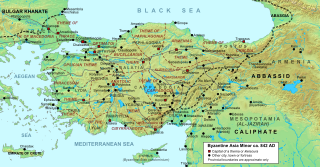
Chaldia was a historical region located in the mountainous interior of the eastern Black Sea, northeast Anatolia. Its name was derived from a people called the Chaldoi that inhabited the region in antiquity. Chaldia was used throughout the Byzantine period and was established as a formal theme, known as the Theme of Chaldia, by 840. During the Late Middle Ages, it formed the core of the Empire of Trebizond until its fall to the Ottoman Empire in 1461.
Gabras or Gavras feminine form Gabraina (Γάβραινα), is the name of an important Byzantine aristocratic family which became especially prominent in the late 11th and early 12th centuries as the semi-independent and quasi-hereditary rulers of Chaldia.
The siege of Trebizond in 1222–1223 was an unsuccessful siege of Trebizond, the capital of the namesake empire, by the Sultanate of Rum under a certain Melik. According to the late 14th-century Synopsis of Saint Eugenios of John Lazaropoulos, the city was close to being captured but was saved by an unusually severe storm. The Seljuq assaults were repulsed, and their army was annihilated on its retreat through the attacks of the Matzoukaites, fierce mountain tribes under Trebizond's rule, and Melik was captured.
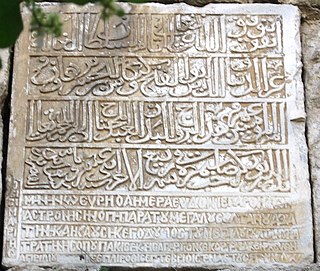
The siege of Sinope in 1214 was a successful siege and capture of Sinope by the Sultanate of Rum under their Sultan, Kaykaus I. Sinope was an important port city on the Black Sea coast of modern Turkey, at the time held by the Empire of Trebizond, one of the Byzantine Greek successor states formed after the Fourth Crusade. The siege is described in some detail by the near-contemporary Seljuq chronicler Ibn Bibi. The Trapezuntine emperor Alexios I led an army to break the siege, but he was defeated and captured, and the city surrendered on 1 November.
Alexander Megas Komnenos, also recorded as Skantarios, was co-emperor of the Empire of Trebizond alongside his elder brother John IV Megas Komnenos c. 1451–1459. Alexander was the second son of the Trapezuntine emperor Alexios IV Megas Komnenos. John was exiled after a failed rebellion against their father in c. 1426, and Alexios made Alexander the designated heir. John returned to Trebizond in early 1429 and seized the throne, killing Alexios and forcing Alexander into exile.
The Treaty of 1282 was an agreement between Empire of Trebizond and the Byzantine Empire. It was signed by emperors John II of Trebizond and Michael VIII Palaiologos.

Alexios V Megas Komnenos was very briefly Trapezuntine emperor in April 1460, succeeding his uncle John IV, until his deposition by his other uncle, David. Alexios was the son and only known child of Alexander, a brother of John IV and David. Alexander served as co-emperor with John IV but died prior to 1460, which left the young Alexios as John IV's heir. Almost immediately after Alexios's accession, David, with support of the influential Kabazites family, deposed Alexios and took the throne for himself.


